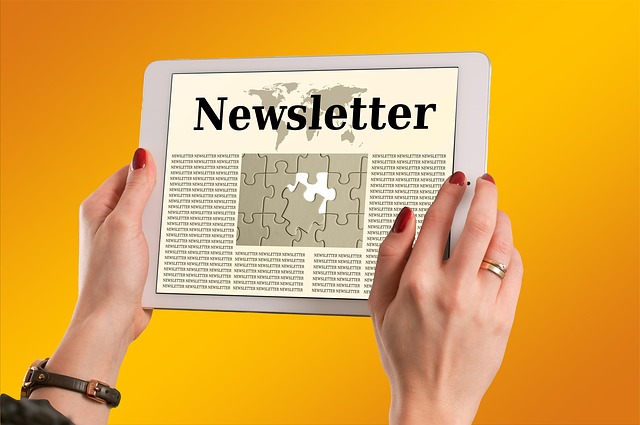How Can a Newsletter Grow Your Blog Community?
When thinking about using a newsletter to build my email list for marketing there are many questions I asked myself about it’s effectiveness.
My questions about newsletters as a viable medium for marketing include:
- Are Email’s old fashioned or effective?
- Isn’t an RSS feed a much more popular avenue moving forward?
- What about Social Networking? Isn’t social media more effective than email newsletters?
- Aren’t Newsletters very one way and not very conversational?
- Isn’t building a ‘list’ as a way of doing online marketing a thing of the past?
- Doesn’t my Blog replace the newsletter?
While I understand why people would ask these types of questions, I did myself. if I had to name one technology or medium that has had the greatest impact upon building my blogs readership, newsletters would be at the top of my list. It’s a terrific way to buid your email list while creating great customer engagement.
8 Benefits Newsletters Bring
Before I continue, let me say that I’m not talking about RSS to email newsletters that simply convert your RSS feed into emails. I’m talking about building a list of subscribers who get a weekly or monthly purpose written newsletter.
Your newsletter might point people to your blog and posts you’ve written but it should be written with a specific purpose in mind. To maintain exclusivity my newsletter often includes other material that’s only available to my newsletter subscribers.
Newsletters Create Brand Loyalty
It’s sad but true that the majority of your blogs readers never come back. The reality is that despite your best efforts, there’s a lot of pass through traffic on most blogs. People arrive from a search engine, another blog or website or a social media site. They may stay for a few moments, consume what they can and then move on.
Unless you find a way to ‘hook’ people into returning to your blog the majority of your readers won’t return. It’s not that they don’t want to or that your site is bad. They are inundated with information every time they go online. They just forget and/or have no means to remind themselves of your blog.
A newsletter is a great way of giving those people who arrive on your blog a way to opt in to being reminded to come back to your blog. The same can be said for RSS but a newsletter reaches a different crowd to RSS.
Newsletters Develop Relationships and Trust
You want to make your newsletter personable, include a photo of yourself and occassional snippets about your life. It’s all a matter of making you familiar to your subscribers. As your subscribers get to know you and their trust builds you will begin to get some interesting interactions from them. They’ll begin emailing you like they’d email a friend.
What I’m finding is that the weekly newsletters are making me very familiar to my subscribers. They seem to feel like they ‘know me’. It’s difficult to explain but I guess when you get as many emails from someone as these people get from me, they really do ‘know me’, at least on some level.

Not only do emails build relationships and intimacy with your readership, they build trust. My newsletter subscribers respond to affiliate promotions much more than my normal blog readers. They seem to follow the recommendations that I make and try the things I suggest.
RSS and just blogging can build relationships and trust also, however I suspect adding email newsletters into the mix adds to it.
Newsletters Drive Page Views/Traffic
My biggest traffic days are those that I send out newsletters. I use newsletters to highlight new posts on the blog and key discussions in the forum that I run. The more helpful and topical the posts and discussions the more traffic the links in the newsletter drives.
If you need a huge traffic boost to a particular post a newsletter can be great for this. For example:
- if you’re launching a new product or service and want to kick it off well – do it with a newsletter as well as a blog post
- if you’re launching a new affiliate campaign – do it the same day you send a newsletter
- if you’re wanting a post to do well on a social bookmarking site like Digg – put a digg button on the post and a few minutes later send out your newsletter pointing people at the post.
These sudden bursts of traffic can really help build momentum around the projects that you’re starting.
Newsletters are Familiar
Most of your readers don’t know what RSS is and unless you offer them an email subscription option they are unlikely to ‘subscribe’. While RSS awareness is growing, some research show RSS use is slowing. I personally feel it’ll continue to grow and be utilized, however email will continue to dominate as the most used form of communication on the planet.
This is a little dependent upon your topic and audience. Some of your readerships will be more tech savvy than others and in those cases email newsletters may not be quite as effective. I suspect in most niches offering a newsletter will be effective.
Newsletters Build Your Core Community
One word that keeps coming up as I interact with my newsletter subscribers is ‘membership’. I don’t use the word but have noticed increasingly that subscribers refer to themselves as ‘members’ or as having signed up for ‘membership’. I find it interesting that these subscribers don’t see themselves as just receiving an email, but as having joined something or being a member of a community.
I guess signing up for something is a reader showing some level of participation and commitment to a site. By doing so they’re investing something in your blog and feel like participants.
I use the words ‘core community’ above because I find that those who subscribe to a newsletter are often among the most loyal and committed members of your blog’s community. These are people who want the inside word on your site and are telling you that they want to know what’s going on as soon as they can.
They’ve given you permission to contact them. Because of this they’re a powerful group of people to know and be able to communicate with. They can actually help you grow your blog further as they can be effective evangelists for you as they share your content.
Newsletters Track and Target Your Readers
Using Google Analytics to test and track your newsletter performance gives you access to all kinds of interesting tools, stats and opportunities. You can track which links in your post get the most clicks. This can be used as a form of research into what your readers respond to. But you can also segment readers into different groups and target them with individual messages.
For example:
- You can send special newsletters just to new subscribers – for example you could send an email every month just to those who’ve signed up in that time highlighting key posts in your archives.
- You can track who clicks on affiliate links in your posts and send them emails with special offers
- You can send special emails just to subscribers who never open emails (testing subject lines with different strategies in them)
Really there is no limit as to what you can test and how you can target readers.
Newsletters Build Momentum
You can use your newsletter not only for promotion of content and affiliate products but to build a sense of momentum on your blog. Every few weeks I’ll give subscribers a little extra insight into milestones that we’ve reached as a community.
Provide any mentions we’ve had in other media, new features that you’ve added etc. Doing this you will give your subscribers a sense that they’re a part of something that is growing and exciting.
I find that as I do this that readers respond very well and give me feedback. They also are eager to tell how they’ve been helping the site to grow by promoting it to their friends.
Newsletters Make Monetization Possible
Newsletters open up another avenue for profit for those of you developing online businesses. I’ve mentioned times that newsletters can be effective when it comes to promoting affiliate programs. They can also be good when it comes to advertising revenue.
Selling ad space in your newsletter can be lucrative when you build up your readership. I’ve found that advertisers can be willing to pay quite good CPM rates because they know a newsletter subscriber base are usually pretty committed and loyal readers. Advertisers understand howthey are very focused around a niche too.





